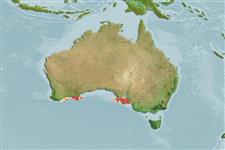Environment: milieu / climate zone / depth range / distribution range
Ökologie
seewasser riff-verbunden; tiefenbereich 0 - 10 m (Ref. 57886). Temperate; 34°S - 36°S (Ref. 57886)
Eastern Indian Ocean: Australia.
Size / Gewicht / Alter
Maturity: Lm ? range ? - ? cm
Max length : 11.5 cm TL Männchen/unbestimmt; (Ref. 33839); 10.3 cm SL (female)
Kurzbeschreibung
Morphologie | Morphometrie
Rückenflossenweichstrahlen (insgesamt): 97-112; Afterflossenweichstrahlen: 57 - 64; Wirbelzahl: 52 - 57. The species is distinguished by having a very elongate body; vertebrae 19-22 + 33-36 = 52-57,
dorsal fin rays 97-112, anal fin rays 57-64, D/A 42-51, V/A 23-26; body with scales; supraorbital pore behind eye present; lower preopercular pores 3, the 2 first tubular; posterior infraorbital pores 3; broad angle on ventral maxilla positioned behind rear of eye; exposed opercular
spine bent upwards; lower lip with skin folds; single pair of pseudoclaspers curved, hockey stick-like, thin; penis slightly shorter than pseudoclaspers, with hook at tip; otoliths rounded anteriorly and expanded posteriorly, without postdorsal angle, otolith length to height ratio
2.3-2.4, sulcus wide (Ref. 57886).
A locally abundant, secretive species inhabiting inshore reefs (Ref. 34024). A female specimen ( 77 mm TL) was reported by McCulloch and Waite (1918) to contain three fully developed embryos, 28 mm in total length. Coloration is reported to include dark pigmentation dorsally. Specimens are also commonly found with copepod remains in the stomach (seen from x-rays). Maximum length for female is 103 mm SL (Ref. 57886).
Life cycle and mating behavior
Geschlechtsreife | Fortpflanzung | Ablaichen | Eier | Fecundity | Larven
Møller, P.R. and W. Schwarzhans, 2006. Review of the Dinematichthyini (Teleostei, Bythitidae) of the Indo-west Pacific, Part II. Dermatopsis, Dermatopsoides and Dipulus with description of six new species. The Beagle 22:39-76. (Ref. 57886)
IUCN Rote Liste Status (Ref. 130435)
Bedrohung für Menschen
Harmless
Nutzung durch Menschen
Fischereien: nicht kommerziell
Mehr Information
NamenSynonymeMetabolismusRäuberÖkotoxikologieFortpflanzungGeschlechtsreifeAblaichenSpawning aggregationFecundityEierEientwicklung
Alter/GrößeWachstumLänge-GewichtLänge-LängeLängenhäufigkeitenMorphometrieMorphologieLarvenLarven Pop.Dyn.RekrutierungDichteBRUVS
ReferenzenAquakulturAquakultur ProfilZuchtlinienGenetikElectrophoresesVererbbarkeitKrankheitenVerarbeitungNutrientsMass conversion
PartnerBilderStamps, Coins Misc.LauteCiguateraGeschwindigkeitSchwimmstilKiemenoberflächeOtolithsGehirngrößeSehfähigkeit
Tools
Zusatzinformationen
Download XML
Internet Quellen
Estimates based on models
Preferred temperature (Ref.
123201): 16.8 - 18.3, mean 17.2 °C (based on 51 cells).
Phylogenetic diversity index (Ref.
82804): PD
50 = 0.5312 [Uniqueness, from 0.5 = low to 2.0 = high].
Bayesian length-weight: a=0.00389 (0.00180 - 0.00842), b=3.12 (2.94 - 3.30), in cm total length, based on all LWR estimates for this body shape (Ref.
93245).
Trophic level (Ref.
69278): 3.4 ±0.5 se; based on size and trophs of closest relatives
Widerstandsfähigkeit (Ref.
120179): niedrig, Verdopplung der Population dauert 4,5 - 14 Jahre. (Assuming Fec < 100).
Fishing Vulnerability (Ref.
59153): Low vulnerability (10 of 100).
